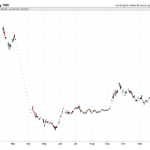Silver has been a valuable commodity for centuries, with its price fluctuating over time due to various economic and political factors. The year 1976 was no exception, as silver prices experienced significant fluctuations throughout the year.
This article provides a historical look at the fluctuations in silver prices in 1976, including monthly prices and a chart of composite prices.
One example of the impact of silver prices in 1976 can be seen in the United States’ Bicentennial Quarter. In honor of the country’s 200th anniversary, the US Mint produced a special quarter that featured a unique design with the image of a colonial drummer.
However, due to the rising cost of silver, the quarter was made with a composition of 91.67% copper and 8.33% nickel, rather than the traditional silver composition. This decision was made to save costs and avoid the need for a price increase, highlighting the importance of silver prices in various industries and sectors.
1976 Silver Prices
The daily silver prices in 1976 fluctuated between $4.09 to $5.08/oz, with the highest price recorded on November 15 at $4.57/oz.
The available historical data shows that the prices remained relatively stable from August to mid-November, consistently above $4.20/oz.
However, the prices declined towards the end of November and throughout December, generally staying below $4.30/oz.
These price fluctuations in 1976 presented opportunities for investment in silver, especially for those who could identify the trends and capitalize on them.
Additionally, mining production would have been affected by the varying prices, as profitability would have depended on the cost of production relative to the market price.
Overall, the historical data on silver prices in 1976 provides useful information for investment analysis and understanding the factors that affect the precious metal’s value.
Monthly Prices
Examining the monthly data on the cost of silver in 1976 reveals a pattern of stability in August and September, followed by a peak in November and a decline in December. From mid-August to mid-November, the price of silver generally remained above $4.20/oz, with the highest price recorded on November 15 at $4.57/oz. However, the price dropped in late November and December, with the lowest price recorded on September 1 at $4.09/oz. Overall, December saw silver prices generally below $4.30/oz.
These seasonal trends in silver prices had different impacts on the industry. The stability in August and September may have provided a sense of security for businesses relying on silver, allowing them to plan and budget accordingly. On the other hand, the peak in November may have caused some concerns for businesses if they were not prepared for the sudden increase in price. The decline in December may have been beneficial for businesses looking to purchase silver at a lower cost, but it could have also been a negative impact on those involved in the silver industry, such as miners or refiners.
Spot Price Chart
Utilizing the LBMA spot price chart, one can analyze the composite prices of silver during the time period, without any analysis or commentary provided.
The chart displays the fluctuations in silver prices throughout the year without any explanation for the observed trends.
Analyzing the trends in the chart, silver prices remained generally stable from July to November, with a peak on November 15th at $4.57/oz.
However, prices declined in late November and December, with the lowest price recorded on September 1st at $4.09/oz.
Analyzing historical trends in silver prices can provide insights into predicting future prices.
However, it is important to note that there are many factors that can affect silver prices, including supply and demand, economic and political events, and market sentiment.
Therefore, while historical data can be useful in understanding trends, it should not be the sole basis for investment decisions.
Frequently Asked Questions
What were the main economic or political factors that influenced the fluctuations in silver prices in 1976?
Inflationary pressures and US government policies were key factors influencing fluctuations in silver prices in 1976. However, further analysis is required to identify specific events and their impact. A data-driven, objective approach is recommended for historical research.
How did the silver prices in 1976 compare to the prices of other precious metals like gold or platinum?
Silver vs. Platinum: A Comparison shows that historically, platinum has been more expensive than silver. However, in 2021, silver is a more attractive investment opportunity due to its lower price and potential for growth.
Were there any notable events or developments in the silver industry in 1976 that could have affected prices?
Economic factors and silver industry developments played a role in silver prices in 1976. The Hunt Brothers attempted to corner the silver market, leading to a price spike in early 1980.
How did the global market for silver affect the prices in the United States in 1976?
Global demand for silver and the state of the mining industry had an impact on silver prices in the United States in 1976. However, without further information on specific events or factors, it is difficult to determine the extent of their influence.
How has the price of silver in 1976 impacted the current market for silver and precious metals?
The price of silver in 1976 may have some impact on the current market for silver and other precious metals, particularly on investment decisions. Industrial uses of silver also play a significant role in determining the demand and price of the metal. However, other factors such as global economic conditions, supply and demand, and geopolitical issues also influence the market.





